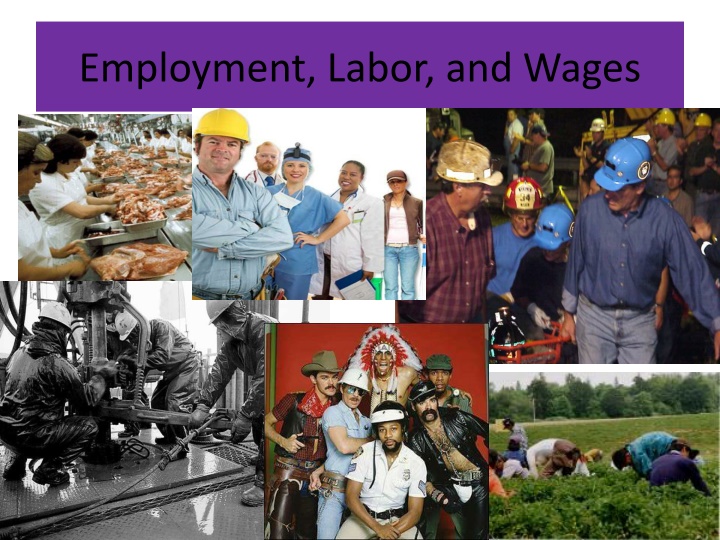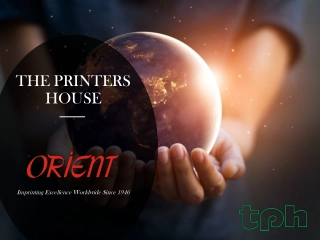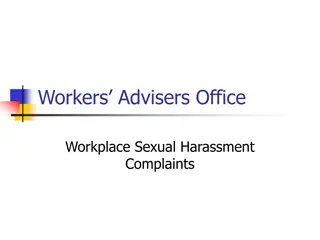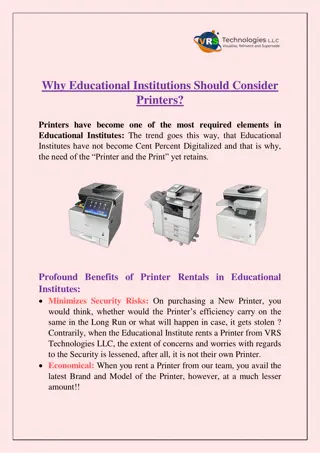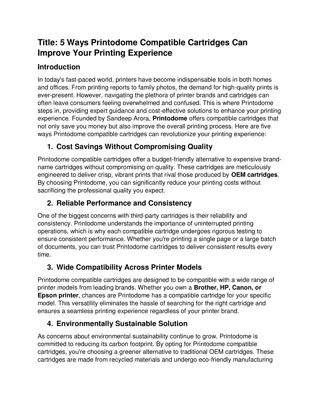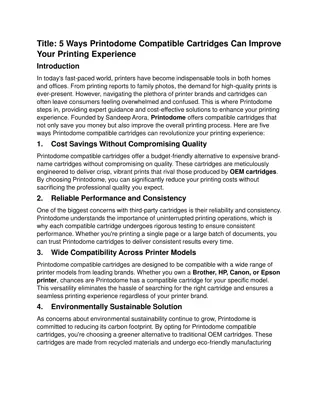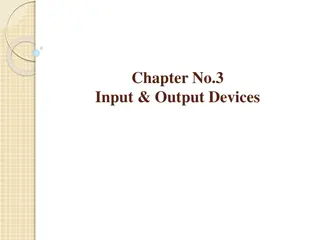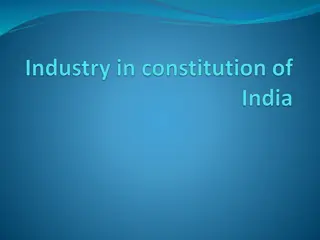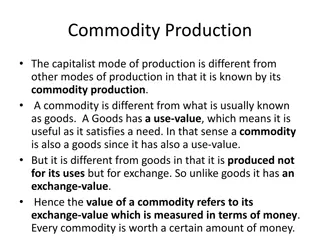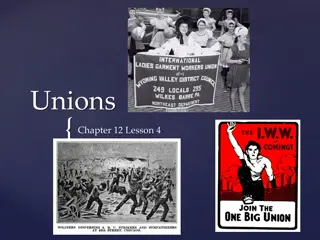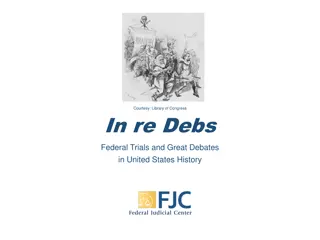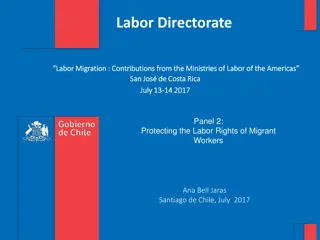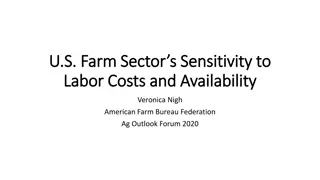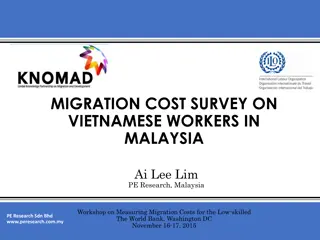Evolution of Labor Movement in America: From Printers to Industrial Workers
Labor movement in America started in 1778 when printers in New York City demanded higher pay, leading to the formation of labor unions. Over the years, the workforce shifted from farmers to factory workers due to immigration and industrialization. The Civil War and westward expansion further fueled the growth of manufacturing jobs, leading to the rise of unions to address challenging working conditions. Two main types of unions emerged - Craft or Trade Unions and Industrial Unions - representing workers in various industries. Unions engaged in activities like strikes, pickets, and boycotts to negotiate better pay, job security, and working conditions. Employers resisted unionization, leading to conflicts such as the Ludlow Massacre where workers demanded better treatment from mining companies.
Download Presentation

Please find below an Image/Link to download the presentation.
The content on the website is provided AS IS for your information and personal use only. It may not be sold, licensed, or shared on other websites without obtaining consent from the author.If you encounter any issues during the download, it is possible that the publisher has removed the file from their server.
You are allowed to download the files provided on this website for personal or commercial use, subject to the condition that they are used lawfully. All files are the property of their respective owners.
The content on the website is provided AS IS for your information and personal use only. It may not be sold, licensed, or shared on other websites without obtaining consent from the author.
E N D
Presentation Transcript
Employment, Labor, and Wages village_people_narrowweb__300x2880.jpg
The Labor Movement Today, one out of every eight working Americans is a member of a labor union In 1778, printers in New York City joined together to demand higher pay this was the first attempt to organize labor in America Until about 1820 most of America s workforce was made up of farmers, small business owners, and the self-employed This changed tremendously over the next 100 years due to immigration and the industrial revolution
The Labor Movement The Civil War and westward expansion added to the boom in manufacturing jobs; soon one-fourth of the nation s working population were hourly factory workers Working conditions in many industries were difficult and dangerous. Soon workers began to unite despite their cultural and linguistic differences Public opposition to unions began to lessen as the public became aware of the hardships factory workers were suffering
Types of Unions Two main types of unions began to develop: 1. Craft or Trade Unions labor union whose members perform the same kind of work ex. machinists, plumbers, etc. 2. Industrial Unions labor union whose members perform different kinds of work in the same industry ex. steelworkers or mineworkers
Union Activities Unions tried to help workers by negotiating for higher pay, job security, and better hours and working conditions. They used several activities to accomplish this: 1. Strike union-organized work stoppage designed to make an employer meet union demands 2. Picket demonstrate or march before a place of business to protest a company s actions 3. Boycott refusal to buy products from an employer or company
Employers Resistance Employers resisted worker s attempts to unionize they felt workers should be paid as little as possible so their cost for labor would be as low as possible, just like they would try to negotiate the cost of any factor of production down as low as possible Employers quickly developed two ways to fight unions: 1. Lockout management refusal to let employees work until managements demands are met 2. Company Unions union organized, supported, or run by an employer
Conflicts Over Unions The Ludlow Massacre The United Mine Workers of America had organized a strike against a mining company owned by John D. Rockefeller to demand better pay and working conditions. The mine company then forced workers and their families out of company owned housing. The miners set up tents and the strike continued for fourteen months. Fights broke out between miners and the company s guards one fight became an all-day battle and devastating fire that left 2 women, 11 children and many men dead http://www.du.edu/ludlow/cfphoto.html
Attitude of the Courts Through this time period the courts consistently ruled against unions. Unions were considered conspiracies against business. The Sherman Antitrust Act of 1890 was designed to curb monopolies, but it was commonly used against union. The United Hatters Union called for a boycott of stores who sold hats made by a manufacturer in Danbury Connecticut. The Supreme Court ruled that the boycott was restraint of trade and thus illegal under the Sherman Antitrust Act
Attitude of the Courts Unions were able to get relief with the Clayton Antitrust Act of 1914. It expressly exempted labor unions from prosecution under the Sherman Act Unions did not get much support from any of the three branches in the 1800 s and up to about the 1930 s. The attitude did start to improve during the Progressive Movement at the turn of the century
Labor Since the 1930s During the Great Depression, the unemployment rate reached as high as 25%. The average manufacturing wage fell from 55 cents an hour in 1929 to 5 cents an hour in 1933 These tough economic times united workers and changed attitudes towards labor throughout the country.
Pro-Union Legislation The Norris LaGuardia Act of 1932 prevented federal courts from issuing rulings against unions engaged in peaceful strikes, picketing, or boycotts. This forced companies to negotiate directly with their unions during labor disputes The National Labor Relations Act, or Wagner Act, of 1935 established the right of unions to collective bargaining. The act also created the National Labor Relations Board (NLRB) giving it the power to police unfair labor practices and certify union election results.
Pro-Union Legislation The Fair Labor Standards Act of 1938 applied to businesses that engage in interstate commerce and set the first minimum wage. It established time- and-a-half pay for overtime, which was defined as more than 40 hours per week. The act also prohibited child labor, which includes any labor for a child under 16 and work that is hazardous to the health of a child under 18
Antiunion Backlash After WWII, public opinion shifted against the unions again. Some people felt communists had entered the unions and people grew tired of strikes disrupting production The Labor-Management Relations Act, or Taft- Hartley Act, of 1947 included a tough antiunion provision that allows individual states to pass right- to-work laws a state law making it illegal to force workers to join a union as a condition of employment, even though a union may already exist
Antiunion Backlash 22 states currently have right-to-work laws The Labor-Management Reporting and Disclosure Act, or Landrum-Griffin Act, of 1959 requires unions to file regular financial reports with the government and limited the amount of money union officials could borrow from the union This was an effort to stop criminal influences from corrupting unions
The AFL-CIO The American Federation of Labor began in 1886 as an organization of craft or trade unions. It later added several industrial unions. The two types of unions often disagreed and eight of the industrial unions left to form the Congress of Industrialized Organizations headed by John L. Lewis of the UMW in 1937. The CIO expanded and grew stronger and had 7 million members by the 1940s
The AFL-CIO In 1955 the AFL and CIO joined together to form the AFL-CIO In 2005 several unions split from the AFL-CIO to form the rival Change to Win Coalition The remaining AFL-CIO members want to focus on lobbying politicians The Change to Win Coalitions wants to focus its efforts on recruiting new union members Independent Unions - are not affiliated with either the AFL-CIO or Change to Win Coalition
Kinds of Union Arrangements Closed Shop arrangement under which workers must join a union before they are hired made illegal by Taft-Hartley Union Shop arrangement under which workers must join a union after being hired Modified Union Shop arrangement under which workers have the option to join a union after being hired Agency Shop arrangement under which nonunion workers must pay union dues
Unions Today The Civilian Labor Force is the men and women 16 years old and over who are either working or actively looking for a job the civilian classification excludes the prison population, other institutionalized persons and members of the armed forces About 12.5 percent of working Americans are union members Union membership varies greatly by occupation, area of the country, and age and race
Wage Determination Wage rate prevailing pay scale for work performed in an occupation Wage rates differ from occupation to occupation and sometimes even within an occupation there are four theories to explain this 1. Noncompeting Categories of Labor there are four broad categories of labor that have different levels of knowledge and skills the highest pay goes to people in jobs that require the most skills and training
Wage Determination Unskilled Labor workers not trained to operate specialized machines and equipment Semiskilled Labor workers who operate machines that require a minimum amount of training Skilled Labor workers who are trained to operate complex equipment and require little supervision Professional Labor workers with a high level of training, education, and managerial skills
Wage Determination 2. Market Theory of Wage Determination states that the supply and demand for a worker s skills and services determine the wage or salary There is a limited supply of workers who can hit major league pitching for average and power and who can play catcher at a high level, but there is a demand from at least 30 firms, so the price for them is high. Equilibrium Wage Rate wage rate leaving neither a surplus nor a shortage in the market
A Labor Market Wage Rate LS $7 Equilibrium Wage the wage rate at which the quantity of labor demanded equals the quantity of labor supplied LD 1,000 Labor Hours
Wage Determination 3. Theory of Negotiated Wages states that the bargaining strength of organized labor is a factor that helps to determine wages in almost all professions, union workers have higher wage rates than non-union workers in those professions Seniority the length of time a person has been on a job 4. Signaling Theory states that employers are willing to pay more to people with certificates, degrees, and other indicators that signal superior knowledge or ability
Resolving Labor Disputes Labor management relations usually require collective bargaining negotiations that take place between labor and management over issues such as pay, working hours, health care coverage, and other job related matters. During collective bargaining, elected union officials represent workers, and company officials in charge of labor relations represent management Collective bargaining requires compromise from both parties, and the discussions over issues may go on for months
Resolving Labor Disputes Grievance Procedure provision in a labor contract that outlines how future disputes and disagreement Mediation process of resolving a dispute by bringing in a neutral third party Arbitration or Binding Arbitration agreement by two parties to place a dispute before a third party for a binding settlement Fact-finding agreement between union and management to have a neutral third party collect facts about a dispute and present nonbinding recommendations
Resolving Labor Disputes Injunction court order issued to prevent a company or union from taking action during a labor dispute Seizure temporary government takeover of a company to keep it running during a labor- management dispute Presidential Intervention may enter a labor- management dispute by publicly appealing to both parties. They can also fire striking federal employees Reagan fired striking air-traffic controllers in 1981
Decline of Union Influence 1. Many employers have made a determined effort to keep unions out of their businesses 2. New additions to the labor force women, teenagers, people working part-time jobs have had little loyalty to unions 3. Unions have had success to the point where they have raised wages so much the products they produce are no longer competitively priced
Renegotiating Union Wages A Giveback wage, fringe benefit, or work rule given up when renegotiating a contract Some companies have filed bankruptcy and federal bankruptcy courts usually allow management to terminate union contracts and establish lower wage scales Two-tier wage system wage scale paying newer workers a lower wage than others already on the job
The Workforce and Gender Reasons women get lower pay: 1. Human Capital Differences about 1/3 of the income gap is due to differences in the skills and experience women bring to the labor market 2. Gender and Occupation slightly less than 1/3 of the wage gap is due to the uneven distribution of men and women among various occupations men tend to work in higher-paying construction and engineering trades while women work in household service and office occupations
The Workforce and Gender 3. Discrimination slightly more than 1/3 of the gap cannot be explained by specific reasons. Economists attribute this portion of differences in income to discrimination. Women and minorities often encounter difficulties in getting raises and promotions that are like reaching a Glass Ceiling an invisible barrier that obstructs their advancement up the corporate ladder
The Workforce and Gender Legal remedies: The Equal Pay Act of 1963 prohibits wage and salary discrimination for jobs that require equivalent skills and responsibilities it applies only to men and women who work at the same job in the same business establishment The Civil Rights Act of 1964 prohibits discrimination in all areas of employment on the basis of gender, race, color, religion, and national origin it applies to businesses with 15 or more employees it also established the Equal Employment Opportunity Commission (EEOC) to investigate complaints
The Workforce and Gender Market Remedies: Set-aside Contract a guaranteed contract or portion of a contract reserved for a targeted group usually a minority The federal government often requires that a certain percentage of defense contracts be reserved exclusively for minority-owned businesses Many of these programs have graduation clauses so a business can only get set-aside contracts for a certain period of time
M i n i m u m W a g e
